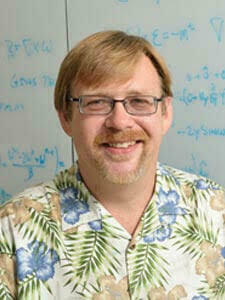
Andrew Christlieb
Michigan State University
4:30 PM
127 Hayes-Healy
Colloquium Tea held at 4:00 pm in 101A Crowley Hall
A new Particle-In-Cell method based on integral equations
Plasma is the 4th state of matter, making up 99% of the visible universe. The fundamental model that describes a plasma is the Boltzmann equation. In recent years, a range of innovative methods that mitigate the curse of dimensionality have arisen. While interesting mathematically, in general these methods are not ready to address generic problems in physics and engineering. It remains the case that the fundamental workhorse for problems where kinetic effects are needed is the explicit Particle-In-Cell (PIC) method. Particle-In-Cell models the plasma as a collection of macro particles. For reasons of efficiency, PIC introduces a mesh that acts as an intermediary, such that the particles are mapped to the mesh for computing the electric and magnetic fields, and then the fields are mapped back to the particles prior to the particle update. It is worth noting that for a range of problems where the plasma is not quasi neutral, as in the case of a resonator such as a travelling wave tube or magnetron, these methods out preform existing mesh-based methods because they do not numerically diffuse the particle beam. While PIC has had a range of advances over the past 60 years, there are still a range of open problems. These include addressing complex geometry in a robust manner, needing to resolve the Debye length to avoid numerical heating, and incorporating the effects of collisions in an efficient and inexpensive manner. These last two challenges become difficult for high density plasmas.
In this talk we explore an alternative formulation to the traditional PIC method for electromagnetic plasmas based on integral solutions. Integral solutions to field equations are a powerful tool for developing efficient and accurate solutions to the evolution of plasmas. Here we give an overview of recent advances in this area that has lead to an O(N) solver for electromagnetic plasma simulations that has several desirable properties, not the least of which is its mesh independent heating rate, heating less than a 1/10th of a percent per 1000 angular plasma periods. This method works with the vector potential formulation of Maxwell’s equations under the Lorenz gauge and advances the particles using the canonical momentum. The wave equations are solved using the Method-Of-Lines-Transpose (MOLT), which is an unconditionally stable field solver that can be made arbitrarily high order in space and time, and an improved version of the Asymmetric Euler integrator for advancing the particles under the canonical momentum is employed. The approach is applied to a host of common test problems and shown to perform better than traditional Particle in Cell on these tests at the same cost. Further, the method opens the door to addressing complex geometry in a scalable setting.
This work is in collaboration with Dr. William Sands, Mr. Stephen White and Mr. Mandela Quashie. Further, this work is supported by AFOSR.
View Poster